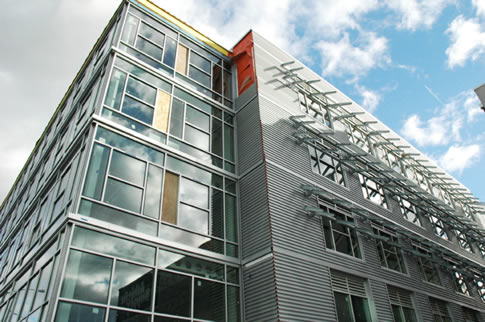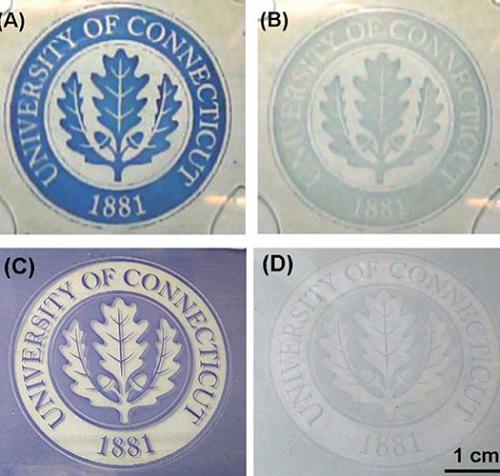Color-Change Tech for Lenses could turn Buildings into Chameleons!
Say what you will about the 1990’s, the decade produced some severely under-appreciated and entirely too short-lived cultural moments: I mean, Hammer pants? Titanic? Come on – you know you loved it! Another phenomenon of the 1990’s that in some ways is slightly less exciting than the OJ Simpson trial, but which has stayed with us to this day is: green-tinted glass.
Image courtesy metaefficient.com
No one knows exactly how it started, but I imagine that sometime in the 1990’s, an architect somewhere in the world specified green-tinted glass for the fenestration on a prominent building. This building was probably published in a print magazine that a lot of other architects read, and somehow, without even knowing what was happening, they all suddenly wanted to use green glass on their projects too. I completely understand: the exact same thing happened to me when I was reading Elle and saw that Heidi Klum decided to cut bangs (and yes, mine are still growing out).
Image courtesy instyle.com
What if there was a way to have your green glass cake when it felt trendy, and then not have the same cake twenty years later when it was moldy and dated, and kind of sad looking? I think perhaps there is!
I recently learned that a University of Connecticut scientist has developed a method that allows films and displays to change color. The obvious application for this technology is sunglasses, and everyone from Hollywood stars to the U.S. military are interested in lenses that respond to changes in the environment to make it easier to see (or be seen).
Typical transition lenses use photochromic films, which are sheets of polymers that change color when light hits them. The new color-changing technology uses electrochromic lenses; these are controlled by an electric current passing through them that adjusts when triggered by a stimulus such as light (Physorg.com). The arrangement is similar to a double-pane window with a gel sandwiched between the glass.
Image courtesy physorg.com
That’s what got me thinking that this material, which can change color as quickly as electricity can travel through it (ie instantaneously) could be great for buildings. The polymer used by the scientists creates less waste and is less expensive to produce than previous mixtures, which is good because for an architectural application, you’d need a lot of it!
I have filed this under fire because electricity creates the color change, and under wood, because it’s a polymer.
Cited:
“A Better Way to Photo Gray: New Technology Allows Lenses to Change Color Rapidly.” Physorg.com 07/12/11. Accessed 07/15/11. URL.


















Has UConn slapped a lawsuit on the logo-theiving USGBC yet?
[…] devoted reader of ARCHITERIALS, you’re probably thinking, “but wait wasn’t there that glass that changes color and then that other really cool irridescent glass film? Hasn’t this been […]
[…] you’re a devoted reader of ARCHITERIALS, you’re probably thinking, “but wait wasn’t there that glass that changes color and then that other really cool irridescent glass film? Hasn’t this been […]
Leave a Wordpress Comment:
Ads
Watch ARCHITERIALS Videos on vimeo
Like on Facebook
Twitter
Flickr
Hit Counter
Ads
Blogs
Green
Journals/Publications
Materials
Network/News
Offices/People
Resources
Science
Pages
Archive
RSS and Email Subscriptions
Tag Cloud
3D 3D printer AB FAB academic acid acrylic actuated matter adaptive adhesive adsorption aerogel air air conditioning alloy aluminum amnh antibacterial antifungal ants april fool's architecture architecture robot artificial skin autonomous aviation awesome bacteria bamboo bananas beer bench bend bending biennale biocomputing biodegradable biodegradeable biomaterials biomimetics biomimicry biominerals biopolymer birds blast blast-resistant block blocks blogs Bloom Box brazil brick bubbles bucky bulk metallic glass butterfly calera canvas carbon carbon fiber carbon nanotubes carpet cars ceiling cellulose cement ceramic chain link chair charcoal charlie sheen chemicals chiller clay cloth cloud cmu coils color color-changing communication compound computer concrete condensation conducting conductive context cool coral cracks crystal cyborg demakersvan design digifab dirt disaster dna dror drywall dutch dynamic EAP earth ecocradle ecolect e coli ecology ecoresin ecovative elastic electric electricity electrochromic electroluminescent electronic energy energy recovery environment evaporative cooling experiment fabric fabrication facade fiber fiberglass fiber optic fiber optics fibers film FIRE flexible flickr fly ash foam fungus furniture garbage gel geodesic dome geometry gfrp gilgamesh glass glass fiber glow glue gold graphene green greensulate gsapp gypsum hard heat heavy heidi klum helix hemp hexagon hidden high performance hive honeybee humidity ice India ink insulation interference Internet inventables invisible invisible ink jello jellyfish just add water kevlar kinetic korea lace lamboo laser lattice leaves LED leed LEGO light light emitting light transmitting liquid lo mein london Loop.pH machines magic magnetic marine material materials meatball melting memory metabolic engineering METAL metal panel metamaterial micro microsensor microtools military milk MIT moisture multi-layer mushrooms mycelium nano nanogel nanotech nanotubes NASA new noise non-metallic oil OLED OMA ostrich oysters packaging paint panel panels paper paperfoam paraffin wax particles particulates petroleum phase change phosphorescent pink PLA plastic platinum pm-10 poetry pollution polymer polymers porcelain power precast printed printing protein public quadror radiant rain rammed earth reclaimed recycled reflective refracting Rem Koolhaas resin robot robotics roof rubber rugged sand sealant sealer search segmented self-healing sensor shape memory silica silicon silk skin skittles slats smog soft solar solar cell solar cells solar paint solid solid state lighting sound spider spider glue spray stabilized sand stone stretch stretchable strong structural structure studio dror sun sunglasses super supercritical sustainable switzerland tags tape technology TED tensile TEXAS textile textiles texture thermal thermochromatic thin thin film thread tiger stone tile tiles timber tio2 tires toaster tokujin yoshioka touch touch-sensitive toxic transparent t shirts tulip ultra-thin university of akron university of connecticut upcycling virus voc wall wallpaper WATER web wet whale wires WOOD woodwool wool workshop
WP Cumulus Flash tag cloud by Roy Tanck and Luke Morton requires Flash Player 9 or better.
Recent Comments
Ads
Recent Posts
Most Commented
Most Viewed